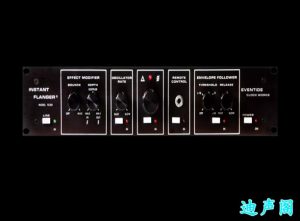
1975年发布的即时弗朗格是为了模拟真正的磁带法兰。当记录工程师发现他们可以把两台磁带机的输出混合在一起,一台比另一台稍微慢一点,并获得一个很酷的新效果时,法兰开始流行。由于它的时滞电路产生了更多的”空档”,并提供了比以往任何东西更深刻的侧翼效果,因此在许多传奇性的唱片中,立即被广泛使用。如果你听过齐柏林飞艇的”身体涂鸦”专辑,你就会听到它的传奇性声音。
电子侧翼:桶旅芯片
从1971年起,埃文丁的第一个效果盒,即即时相相器,被设计用来模拟磁带边缘,但是使用了一系列的”全通”滤波器而不是延迟(这是在音频延迟实际使用之前)。侧翼需要相对较短的延迟,并且延迟必须是从~0到~10毫秒的平稳变化以达到效果。最近出现了数字延迟,但对于如此短时间的延迟来说,成本高昂。直到一种被称为电荷耦合装置(CCD)的芯片发明(通常被称为桶旅),才有可能在一瞬间使其成为可能。这个芯片,虽然是模拟的,可以用来延迟音频.我们联系了日本的三菱制造商。乔·D。黑米全纳印刷器的设计师保罗回忆说:
控制
释放-确定信封追随者在最大信号通过后返回到较低状态的速率。顺时针方向控制增加释放时间,使信封跟踪者跟踪更慢。
深度:深度控制了吸汗延迟信号和”干”信号的混合。旋钮设置为”中午”,只有变化的延迟是输出,导致多普勒效应。设置为完全逆时针,输出是一个平等混合的原始信号和变延迟添加在相位。通过在相位中加入两个信号,低频率得到加强.设置为完全顺时针,变时滞增加不相,导致在低频率下的深空接近直流。
大的旋钮:大的旋钮允许用户用LED的亮度手动控制延迟,表明延迟的数量–短期延迟变暗,最大延迟变亮。使用者可以转动旋钮来扫回延迟,以产生多普勒或侧翼效果。
振荡器:低频率振荡器自动扫过延迟。它改变了扫描率。05赫兹至20赫兹。必要时,振荡器是模拟电路,因此扫描形状只能近似于正弦波。
信封追随者:即时方格结合了即时相相器最重要和最流行的创新之一,有水平的信号的能力改变了延迟。阈值和释放旋钮使用户能够适应不同的输入信号。
组合控制:快速的弗朗格丰富的方法,以手动的方式控制侧翼效果,通过机载振荡器(LFA),信号的包络,或遥控电压(在任何组合!这是相当的创新。可以肯定的是,现在已经很明显了,但是我们还不知道还有什么能提供这种功能的效果设备。
弹跳:弹跳控制的设计是为了模仿磁带记录器伺服电动机的”弹跳”效应,试图恢复到从法兰释放压力后出现在磁带法兰上的速度。
Team R2R | 2024.06.09 | 2.9 MB
The Instant Flanger, released in 1975, was designed to simulate true tape flanging. Flanging first became popular in the 1960s when recording engineers discovered that they could mix the output of two tape machines, one running slightly slower than the other, and get a cool new effect. As its time-delay circuit produced many more “nulls” and offered a much deeper flanging effect than anything previously available, the Instant Flanger became widely used on many legendary recordings. If you’ve ever listened to Led Zeppelin’s “Physical Graffiti” album, you’ve heard its legendary sound.
Electronic Flanging: The Bucket Brigade Chip
Eventide’s first effects box from 1971, the Instant Phaser, was designed to simulate tape flanging but used a series of ‘all-pass’ filters rather than delay (this was before audio delay was practical). Flanging requires a relatively short delay, and that delay must be smoothly varied from ~0 to ~10msec to achieve the effect. Digital delays had recently been introduced, but they were prohibitively expensive for such a short delay. It was not until the invention of a chip called a Charge Coupled Device (CCD), commonly referred to as a Bucket Brigade, that the Instant Flanger was made possible. This chip, analog though it was, could be used to delay audio. We contacted its manufacturer, Mitsubishi, in Japan. As Jon D. Paul, the designer of the black-meter Omnipressor®, recalls:
Controls
Release – Determines the rate at which the Envelope Follower returns to a lower state after the loudest signal has passed. Clockwise on this control increases the release time and makes the Envelope Follower track more slowly.
Depth: Depth controls the mix of the swept-delay signal and the ‘dry’ signal. With the knob set to ‘noon’, only the varying delay is output, resulting in a doppler effect. Set to full counterclockwise, the output is an equal mix of the original signal and the varying delay added in phase. By adding the two signals in phase, low frequencies are reinforced. Set to full clockwise, the varying delay is added out-of-phase, resulting in a deep null at low frequencies down to nearly DC.
The Big Knob: The Big Knob allowed the user to manually control the delay with the LED’s brightness, indicating the amount of delay—dim for short delay and bright for max delay. Users could turn the knob to sweep the delay back and forth to create the doppler or flanging effect.
The Oscillator: The on-board LFO (Low Frequency Oscillator) automatically swept the delay. It varied the sweep rate from .05 Hz to 20 Hz. Of necessity, the oscillator was an analog circuit and consequently the sweep shape can only approximate that of a sine wave.
The Envelope Follower: The Instant Flanger incorporated one of the most important and popular innovations of the Instant Phaser, the ability to have the level of the signal vary the delay. The Threshold and Release knobs gave users the ability to accommodate different input signals.
Combined Controls: The Instant Flanger’s rich complement of ways to control the flanging effect manually, by the on-board oscillator (LFO), the signal’s envelope, or by remote control voltage (in any combination!) was quite the innovation. Obvious now, to be sure, and yet we know of no other effects device that offered this capability.
Bounce: The bounce control was designed to emulate the ‘bounce’ effect of a tape recorder’s servo motor trying to get back up to speed, which occurs in tape flanging after pressure is released from the flange.
主题授权提示:请在后台主题设置-主题授权-激活主题的正版授权,授权购买:RiTheme官网
